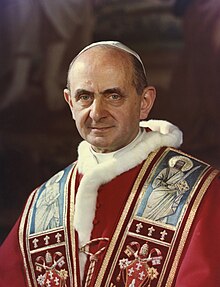Paul VI | |||||||||||||||||||||||||||||||||
|---|---|---|---|---|---|---|---|---|---|---|---|---|---|---|---|---|---|---|---|---|---|---|---|---|---|---|---|---|---|---|---|---|---|
| Bishop of Rome | |||||||||||||||||||||||||||||||||
 Official portrait, 1969 | |||||||||||||||||||||||||||||||||
| Church | Catholic Church | ||||||||||||||||||||||||||||||||
| Papacy began | 21 June 1963 | ||||||||||||||||||||||||||||||||
| Papacy ended | 6 August 1978 | ||||||||||||||||||||||||||||||||
| Predecessor | John XXIII | ||||||||||||||||||||||||||||||||
| Successor | John Paul I | ||||||||||||||||||||||||||||||||
| Previous post(s) |
| ||||||||||||||||||||||||||||||||
| Orders | |||||||||||||||||||||||||||||||||
| Ordination | 29 May 1920 by Giacinto Gaggia | ||||||||||||||||||||||||||||||||
| Consecration | 12 December 1954 by Eugène Tisserant | ||||||||||||||||||||||||||||||||
| Created cardinal | 15 December 1958 by John XXIII | ||||||||||||||||||||||||||||||||
| Personal details | |||||||||||||||||||||||||||||||||
| Born | Giovanni Battista Enrico Antonio Maria Montini 26 September 1897 | ||||||||||||||||||||||||||||||||
| Died | 6 August 1978 (aged 80) Castel Gandolfo, Italy | ||||||||||||||||||||||||||||||||
| Education | University of Milan (JCD) | ||||||||||||||||||||||||||||||||
| Motto | |||||||||||||||||||||||||||||||||
| Signature | |||||||||||||||||||||||||||||||||
| Coat of arms |  | ||||||||||||||||||||||||||||||||
| Sainthood | |||||||||||||||||||||||||||||||||
| Feast day |
| ||||||||||||||||||||||||||||||||
| Venerated in |
| ||||||||||||||||||||||||||||||||
| Beatified | 19 October 2014 Saint Peter's Square, Vatican City by Pope Francis | ||||||||||||||||||||||||||||||||
| Canonized | 14 October 2018 Saint Peter's Square, Vatican City by Pope Francis | ||||||||||||||||||||||||||||||||
| Attributes |
| ||||||||||||||||||||||||||||||||
| Patronage |
| ||||||||||||||||||||||||||||||||
| Shrines | None | ||||||||||||||||||||||||||||||||
Ordination history | |||||||||||||||||||||||||||||||||
| |||||||||||||||||||||||||||||||||
| Other popes named Paul | |||||||||||||||||||||||||||||||||
Pope Paul VI (Latin: Paulus VI; Italian: Paolo VI; born Giovanni Battista Enrico Antonio Maria Montini, Italian: [dʒoˈvanni batˈtista enˈriːko anˈtɔːnjo maˈriːa monˈtiːni]; 26 September 1897 – 6 August 1978) was head of the Catholic Church and sovereign of the Vatican City State from 21 June 1963 to his death on 6 August 1978. Succeeding John XXIII, he continued the Second Vatican Council, which he closed in 1965, implementing its numerous reforms. He fostered improved ecumenical relations with Eastern Orthodox and Protestant churches, which resulted in many historic meetings and agreements. In January 1964, he flew to Jordan, the first time a reigning pontiff had left Italy in more than a century.[9]
Montini served in the Holy See's Secretariat of State from 1922 to 1954, and along with Domenico Tardini was considered the closest and most influential advisor of Pope Pius XII. In 1954, Pius named Montini Archbishop of Milan, the largest Italian diocese. Montini later became the Secretary of the Italian Bishops' Conference. John XXIII elevated Montini to the College of Cardinals in 1958, and after his death, Montini was, with little opposition, elected his successor, taking the name Paul VI.[10]
He re-convened the Second Vatican Council, which had been suspended during the interregnum. After its conclusion, Paul VI took charge of the interpretation and implementation of its mandates, finely balancing the conflicting expectations of various Catholic groups. The resulting reforms were among the widest and deepest in the Church's history.
Paul VI spoke repeatedly to Marian conventions and Mariological meetings, visited Marian shrines and issued three Marian encyclicals. Following Ambrose of Milan, he named Mary as the Mother of the Church during the Second Vatican Council.[11] He described himself as a humble servant of a suffering humanity and demanded significant changes from the rich in North America and Europe in favour of the poor in the Third World.[12] His opposition to birth control was published in the 1968 encyclical Humanae vitae.
Pope Benedict XVI, citing his heroic virtue, proclaimed him venerable on 20 December 2012. Pope Francis beatified Paul VI on 19 October 2014, after the recognition of a miracle attributed to his intercession. His liturgical feast was celebrated on the date of his birth, 26 September, until 2019 when it was changed to the date of his priestly ordination, 29 May.[1] Pope Francis canonised him on 14 October 2018.
- ^ a b "Decreto della Congregazione del Culto Divino e la Disciplina dei Sacramenti sull'iscrizione della celebrazione di San Paolo VI, Papa, nel calendario Romano Generale". Holy See. 6 February 2019. Archived from the original on 7 February 2019. Retrieved 6 February 2019.
- ^ "Memory of Blessd Paul VI". Archdiocese of Milan. 15 May 2015. Archived from the original on 24 May 2015. Retrieved 23 May 2015.
- ^ Chryssides, George D. (2012). Historical Dictionary of New Religious Movements (2nd ed.). Lanham, Md.: The Scarecrow Press. p. 268. ISBN 9780810861947. Archived from the original on 29 April 2024. Retrieved 8 November 2021.
The church has also canonized Francisco Franco, Josemaría Escrivá de Balaguer y Albas, Christopher Columbus, and Paul VI.
- ^ "In the Diocese of Milan. A pastoral community dedicated to Paul VI (in Italian)". 1 October 2014. Archived from the original on 18 August 2015. Retrieved 21 November 2014.
- ^ "About Paul VI, Patron of the Institute". Archdiocese of St. Louis. Archived from the original on 21 March 2015. Retrieved 18 March 2015.
- ^ "Paul VI Blessed! (in Italian)". Diocese of Brescia. 2014. Archived from the original on 2 April 2015. Retrieved 28 March 2015.
- ^ "Letter to the diocese for calling a "Montinian Year" (in Italian)" (PDF). Diocese of Brescia. 2014. Archived from the original (PDF) on 4 June 2016. Retrieved 28 March 2015.
- ^ "CAPOVILLA, Loris Francesco (1915–)". Cardinals of the Holy Roman Church. Archived from the original on 30 December 2017. Retrieved 22 February 2014.
- ^ "The Pilgrimage of Pope Paul the Sixth". Life. 17 January 1964. pp. 18–29. Archived from the original on 29 April 2024. Retrieved 18 January 2011.
- ^ Hebblethwaite 1993, pp. 322–23.
- ^ Commissio Theologica Internationalis, Catholic Church (21 August 2009). Sharkey, Michael; Weinandy, Thomas (eds.). International Theological Commission, Vol II: 1986–2007. Ignatius Press. p. 208. ISBN 978-1586172268.
- ^ 'It's not Easy Being a Christian', says Pope, Rome, Italy: Vatican Radio, 11 August 2009, archived from the original on 7 March 2012, retrieved 19 May 2014